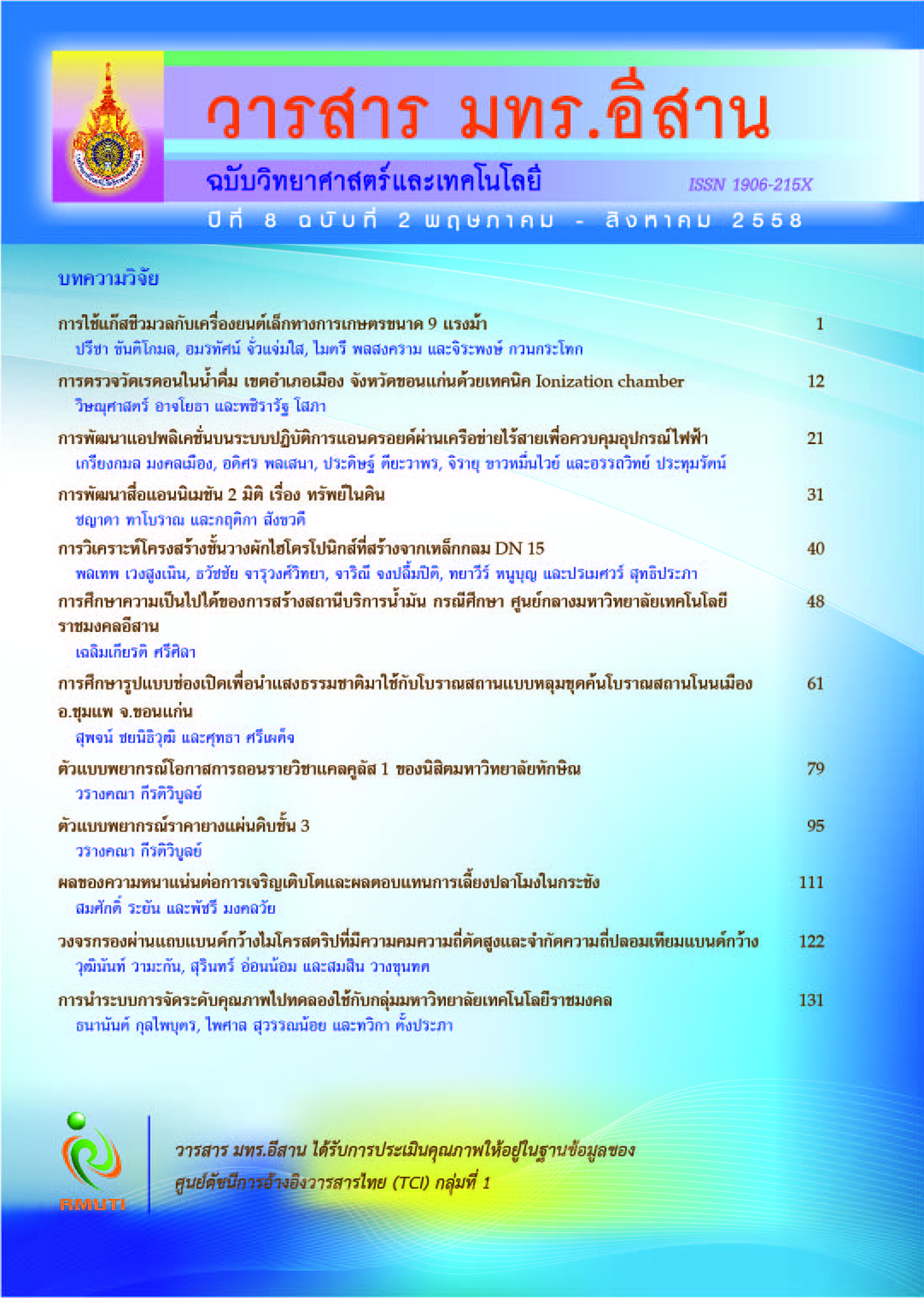การนำระบบการจัดระดับคุณภาพไปทดลองใช้กับกลุ่มมหาวิทยาลัยเทคโนโลยีราชมงคล The System Implementation of the Quality Rating Cluster of Rajamangala University of Technology
Main Article Content
Abstract
บทคัดย่อ
การวิจัยครั้งนี้มีวัตถุประสงค์เพื่อ 1) พัฒนาองค์ประกอบ ตัวบ่งชี้ เกณฑ์ในการจัดระดับคุณภาพกลุ่มมหาวิทยาลัยเทคโนโลยีราชมงคล 2) พัฒนาระบบการจัดระดับคุณภาพ กลุ่มมหาวิทยาลัยเทคโนโลยีราชมงคล ขั้นตอนการวิจัยนี้ มี 2 ระยะ คือ ระยะที่ 1 การพัฒนาองค์ประกอบ ตัวบ่งชี้ เกณฑ์ในการจัดระดับคุณภาพ กลุ่มมหาวิทยาลัยเทคโนโลยีราชมงคล โดยกำหนดขนาดกลุ่มตัวอย่างเป็นผู้บริหารมหาวิทยาลัยเทคโนโลยีราชมงคล 9 แห่งๆ ละ 16 คน รวมเป็นจำนวน 144 คน ใช้การสุ่มตัวอย่างด้วยวิธีเจาะจง คือ แบบประเมินความสอดคล้อง และแบบสอบถามความเหมาะสมขององค์ประกอบ ตัวบ่งชี้ เกณฑ์ในการจัดระดับคุณภาพ กลุ่มมหาวิทยาลัยเทคโนโลยีราชมงคล ระยะที่ 2 การพัฒนาระบบการจัดระดับคุณภาพ กลุ่มมหาวิทยาลัยเทคโนโลยีราชมงคล ผู้วิจัยได้พัฒนาคู่มือระบบการจัดระดับคุณภาพ กลุ่มมหาวิทยาลัยเทคโนโลยีราชมงคลฉบับร่าง จากนั้นนำคู่มือฉบับร่าง เสนอต่อผู้เชี่ยวชาญเฉพาะ จำนวน 6 คน เพื่อตรวจสอบความตรงเชิงเนื้อหา (Content Validity) ก่อนนำไปปรับปรุงตามข้อเสนอแนะ และทดลองใช้ระบบการจัดระดับคุณภาพกับมหาวิทยาลัยเทคโนโลยีราชมงคลจำนวน 4 แห่ง ประกอบไปด้วย มหาวิทยาลัยเทคโนโลยีราชมงคลรัตนโกสินทร์ มหาวิทยาลัยเทคโนโลยีราชมงคลสุวรรณภูมิ มหาวิทยาลัยเทคโนโลยีราชมงคลตะวันออก และมหาวิทยาลัยเทคโนโลยีราชมงคลกรุงเทพ ค่าสถิติที่ใช้ในการวิเคราะห์ข้อมูล คือ ค่า Index of item objective congruence : IOC ค่าเฉลี่ย () และส่วนเบี่ยงเบนมาตรฐาน (SD.)ผลการศึกษามีดังนี้ 1) การพัฒนาองค์ประกอบ ตัวบ่งชี้ เกณฑ์ในการจัดระดับคุณภาพกลุ่มมหาวิทยาลัยเทคโนโลยีราชมงคล พบว่ามี 11 องค์ประกอบ 35 ตัวบ่งชี้ จากการพิจารณาตัวบ่งชี้ที่มีค่าเฉลี่ยสูงสุด คือ บัณฑิตปริญญาตรีที่ได้งานทำ/ประกอบอาชีพอิสระภายใน 1 ปี ส่วนตัวบ่งชี้ที่มีค่าเฉลี่ยตํ่าสุด คือ งบประมาณสนับสนุนจากศิษย์ 2) ผลการทดลองใช้ระบบการจัดระดับคุณภาพกับมหาวิทยาลัยเทคโนโลยีราชมงคล ทั้ง 4 แห่ง ภาพรวมมีระบบการจัดระดับคุณภาพอยู่ในระดับดี ทำให้ทราบถึงข้อมูลสารสนเทศที่เป็นจุดแข็ง และจุดที่ควรพัฒนาของมหาวิทยาลัยเทคโนโลยีราชมงคลทั้ง 4 แห่ง ซึ่งเป็นประโยชน์มากในการกำกับ ตรวจสอบ ติดตามคุณภาพของแต่ละมหาวิทยาลัย และกลุ่มมหาวิทยาลัยเทคโนโลยีราชมงคล ก่อนมีการประเมินคุณภาพภายนอก และการพัฒนาอัตลักษณ์ต่อไป
Abstract
The objectives of the study were: 1) to develop the factors, indicators, and criteria for quality rating at the Rajamangala University of Technology (RMUT) cluster, and 2) to develop a system for quality rating at the university. The study was conducted in two phases. Phase 1 aimed to develop the factors, indicators and criteria by setting up the sample size. The sample selected was 144 participants from the board of the nine RMUT clusters. An objective congruence index form and questionnaires were used to collect the data. Phase 2 was to develop a system for implementing quality rating at the university. The researcher has developed a draft manual for quality rating at the university. Subsequently, the draft manual was submitted to six experts to verify the content and recommend changes. The pilot study was conducted at four Rajamangala Universities of Technology at Rattanakosin, Suvarnabhumi, Tawan-Ok, and Krung Thep. The statistical analysis methods used to analyze the data were index of item objective congruence (IOC), mean score and standard deviation. The findings were: 1) Eleven factors and 35 indicators were developed for quality rating. The indicator with the highest mean score was the employed/self-employed graduate within one year of graduation. On the other hand, the lowest mean score was for alumni requiring financial support. 2) The results of the study at the four RMUT showed a good level of performance in Information Communication Technology (ICT). The recommendations from the pilot study have been used to raise awareness of the development required at Rajamangala University of Technology. Implementation of the findings will be useful for conveying, examining, and monitoring quality at each RMUT university and the RMUT cluster as a whole, before external assessment occurs. This will help to develop the university’s sense of identity.
Article Details
References
by excimer laser evaporation. Thin Solid Films. 288. pp. 248-253.
C. Guill n, J. Herrero. (2006). Influence of oxygen in the deposition and annealing
atmosphere on the characteristics of ITO thin films prepared by sputtering
at room temperature. Vacuum. 80. pp. 615-620.
G.S. Belo, B.J.P. da Silva, E.A. de Vasconcelos, W.M. de Azevedo, and E.F. da Silva Jr.
(2008). A simplified reactive thermal evaporation method for indium tin
oxide electrodes. Applied Surface Science. 255. pp. 755-757.
H. Cho, and Y.H. Yun. (2011). Characterization of indium tin oxide (ITO) thin films
prepared by a sol-gel spin coating process. Ceramics International 37.
pp. 615-619.
H. R. Fallah, M. Ghasemi, A. Hassanzadeh, and H. Steki. (2007). The effect of
annealing on structural, electrical and optical properties of nanostructured
ITO films prepared by e-beam evaporation. Materials Research Bulletin.
42. pp. 487-496.

